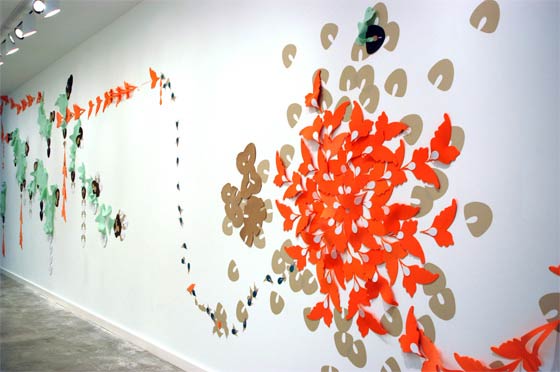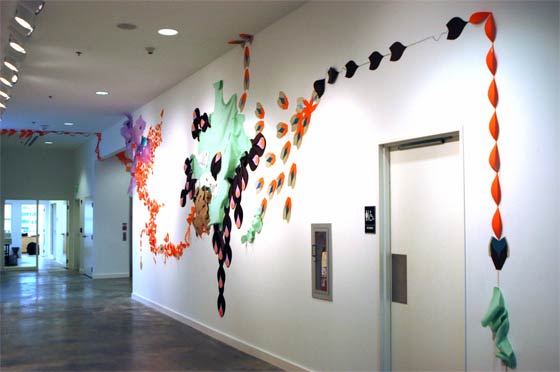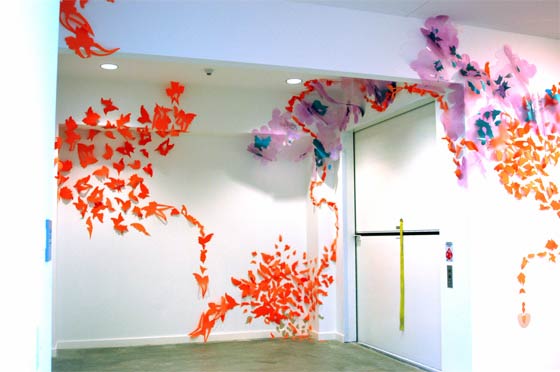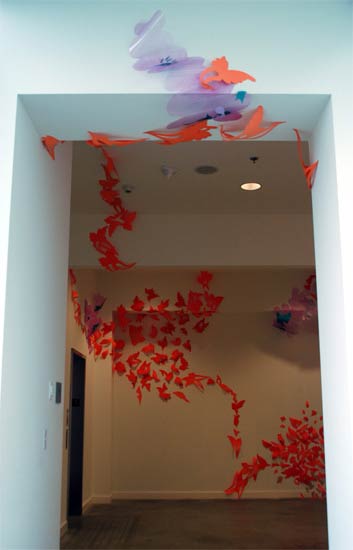Essay: serendipitous hybrids
Kris Douglas' essay on Liz Miller's 'serendipitous hybrids' at the Rochester Art Center.




In his writing on the processes and associations of systems, Gregory Bateson suggests, “when interactions among component processes take the form of causal chains…the representation of time structure is essential. When sequences of cause and effect become circular, then the mapping of those sequences onto timeless logic becomes self-contradictory or paradoxical.”1 The difficulty of applying a linear cause and effect interpretation of system change over time is one of the enticing challenges facing viewers of Liz Miller’s mixed media installations. Her work is informed by an assortment of diverse natural and constructed systems with which humans consistently interact—computer systems, biological systems such as the immune or the circulatory system, weather systems. Although the tendency in interpreting ambiguous stimuli is to seek out narrative or linear relationships, Miller’s work defies simple analysis of systemic change over time. She states her primary interest is in “the ambiguous places where disparate systems intermingle, and the unpredictable outcomes of their meeting.” As these elements–never intended for confluence or influence–combine and adjust, wholly new outcomes come into existence creating something with decidedly different attributes then its constituent parts. The inherent uncertainty at this particular theoretical location is ripe with questions and possibilities.
Her installation pieces, often constructed with carefully cut and arranged bits of synthetic materials such as felt, vinyl, foam, and Plexiglas, feature bold, amplified colors and a variety of textures. These super-saturated, frenzied-yet-controlled patterns resemble contemporary graphic design or consumer-targeted communications. However, initial impressions of seemingly bright, happy, comfortable arrangements may give way to more complex and potentially menacing interpretations. What may at first look like positive natural growth, as in the dispersion or development of a healthy organic system, may morph into contamination and permeation of boundaries. In her installation Failure of an Eloquent Defense, we see the visual outcome of these theoretical strategies. Comprised of three distinct divisions of varying size, form, color, and composition, we begin to see the result of this intricate amalgamation. Although connected by a simple line (either green felt dashes or orange forms resembling a simple boat or ship), each principal element has a distinct structure. One form has the stereotypical appearance of an industrial or computer system—all elements are neatly organized or compartmentalized, with an overall sense of precise regulation. Existing as the most visually familiar set of forms, the influence of contemporary culture, design, or advertising is most apparent in this area. Moving to another distinct location in the installation, the viewer encounters a more complex segment resembling tectonic plates, topographical or geological charts or maps, or a Pangaea-like super continent. Here, we have smaller, more delicate elements joining the primary form, becoming decidedly energetic, moving actively around a complex core. Via layering of form and material, this section becomes more dimensional, protruding off the wall in a fashion unlike the others. The final element is a hectic mix of individual forms, appearing to release from what was once a decidedly intact whole, each seeming to spin out of control and progressing in discrete directions. This has the characteristics of breakdown or disintegration, a self-defeating construction that is near the end of its existence. Taking a literal interpretation from the installation’s title, one could assume these forms have been adversely affected or tainted by one another, altering their states regardless of the level of resistance.
As we can see, Miller is interested in systems in flux, and the fusion of these disparate systems. Although she examines the unsteady distinction between order and chaos, she is particularly interested in the interactions of components or the byproduct of these interactions—”hybrids.” Miller’s original work created specifically for installation in the Rochester Art Center is entitled serendipitous hybrid, suggesting an unforeseen amalgam of systems or their components. As in Failure of an Eloquent Defense, these systems share a thread of connectivity, a linear element joining and demarcating their association to one another. How these elements and forms relate to their particular surroundings, or how the viewer relates to this work within a distinct context is also an essential subject. Miller’s work emphasizes several important aspects of installation art in general. Though difficult to contain all of installation within a brief definition—indeed one primary characteristic is its refusal to accept boundaries—it can be stated that installation art is a genre that attempts to create a sensory, intuitive, and/or conceptual experience within a particular environment. Any media can be used, from natural materials to new media such as sound and video. Oftentimes the space of the gallery is used directly. Like Miller’s serendipitous hybrids, many installations are site-specific, in that they were created in collaboration with the properties of the space where they exist, with many only able to exist within this specific context. Consequently, if the installation is not permanent, it must be known over time primarily through documentation (e.g., photographic, video, written) of its existence in its original location.
In installation art, the concept of the artist may be as important or more important than the formal properties of the work itself. In Miller’s work, theoretical issues regarding systems provides a point for conceptual departure, while the slow and tedious process of cutting and applying these materials within a space grounds the production of the work. This combination of methodologies could be considered a hybrid in itself, two distinctly different acts combining to create new formal elements. Interaction of the viewer with the work is also critical, and some have argued that the viewers themselves are the true sites of the installation. Within the text Installation Art in the New Millennium, installation is described as “moving beyond the physical boundary of a single space into a realm of negotiated interactivity and simultaneity.”2 Miller’s work invites the audience to interact with her constructed systems though consideration of order versus chaos, boundaries bypassed, and the products of the unexpected collision, explosion, and morphing of systems.
Notes:
1. Gregory Bateson, Mind and Nature: A Necessary Unity, Penguin USA
2. Nicolas De Oliveira, Installation Art in the New Millennium, Thames and Hudson